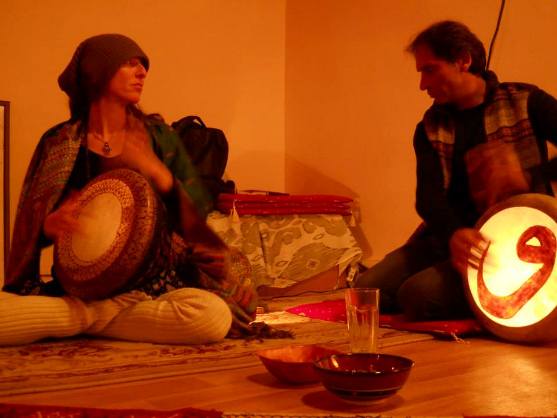We Drum Because We Can’t Stop our Fingers from Moving.
{Photo: Jerome Burdi}
By Jerome Burdi.
Drumming in unison with Bünyamin is like being in the sphere of the sun, the source of energy, burning bright.
Then he goes off on a tangent, his fingers dancing, striking a flurry of notes on the drum with the precision of a tightrope walker. In the moments he’s playing, the darbuka is the only instrument in the world. He takes you over with a sound that seems impossible, a sound only a master can make.
“The drum is a world of sound,” he said in Turkish. “Explore it.”
Bünyamin has a gracious demeanor. He doesn’t speak English, but looks into your eyes with a smile and deep understanding. When he’s in the heart of his playing, he locks in with a wild gaze, whipping his head from side to side in the flow of the music, slamming down individual fingers with the strength of a fist.
When he’s in the zone, you fall into the zone, riding the wave of rhythm wherever it goes. He can pull you into his wave, and all of a sudden you’re playing better than you thought you could.
The Turkish split finger style came out about 20 years ago, so it’s still new and exciting. In traditional Arabic darbuka playing, the rhythm is held with the right hand (if you’re a righty) and accents are made with the left ring finger. The Turks changed this to include the forefinger as well. This adds a lot more notes, especially to drum rolls, making them sound like rain crashing on a tin roof.
Because the style’s so new, Bünyamin turns to India for drumming inspiration. You can see that in his style; the sharp hits on the edge of the drum, the smooth pops and rolls that recall the great masters of the East.
But the Turkish style has its own sound, filling the Istanbul night. Ahh, the magic of an Istanbul night is like walking through a dream.
Outside on busy Istiklal Avenue, baklava glistens in shop windows, Turkish Delight are lined up like jewels, people drink chai from small tulip glasses, mustached men carve meat from cylinders and the flow of people never stops.
An occasional car or trolley passes through, parting the sea of people who then swallow the street up once again in its wake. The musicians take their spots — a saz here, a darbuka player here, a clarinet there, charming the night with their songs.
A few steps away from the shoulder to shoulder avenue, is the vast open space of Taksim Square. Walking through it feels more like flying in the sky. It’s a whimsical area where flocks of pigeons come for breadcrumbs and a photograph from the hands of tourists.
The street and professional darbuka players in Istanbul are impressive and play loud, but I have yet to hear one who can also play soft and skilful like Bünyamin. He has as much control of the sounds he makes on the drum as he does with his larynx.
Besides being a darbuka god, Bünyamin is also a friendly human being. Like many Turkish people, he’s gracious to guests, serving tea with a smile and keeping his prayer beads near.
It’s thanks to Raquy that more people from the West are learning about this drumming style and about the great Turkish masters. Raquy moved from New York City to Istanbul to be close to her teacher Bünyamin and Turkish music.
She is the darbuka player’s bridge between the West and Istanbul, an ambassador of the Turkish split finger technique — giving workshops around the world to enthusiastic professional musicians and beginners alike.
Bünyamin is like a yogi in his cave. He doesn’t play in public, only with Raquy in her storied Darbuka Temple, where many of the greatest Turkish drummers have come to play.
Raquy makes the enigma of Bünyamin more familiar. The Darbuka Queen has developed her own way to make notations out of Bünyamin’s divine inspiration. When he plays a beautiful groove Raquy hasn’t heard, she writes it down to preserve it much like Rumi’s disciples did when he danced and sang the honey of divine poetry.
Raquy is the composer, Bünyamin is the inspired artist. They intertwine each other when they play and become one sound, one breath, moving together, the union of Shakti and Shiva! It’s a beauty to see.
The Adobe Flash Player is required for video playback.
Get the latest Flash Player or Watch this video on YouTube.
By being among the presence of the two, one absorbs so much, drinks in their energy and becomes a better drummer.
Jams in the office go late into the night. The students follow the rhythms set by Bünyamin or Raquy, which may be striking the drum incessantly with one finger for several minutes. You feel your arm stiffen and almost stop moving to where you can barely make a sound on the drum.
But this is where the real work begins, Bünyamin says — it’s where your muscles start to come in places you’d never think you’d need them… your fingers!
Chai is an important part of the hours-long drumming sessions… Raquy prepares a hibiscus and cinnamon blend to keep the drummers strong and energized.
And we keep going… we drum for each other, we drum for the master, we drum for ourselves, we drum because we can’t stop our fingers from moving. We drum because it means more than any verbal conversation can express.
We drum because when we’re in that rhythm, it’s all that matters.
And we ride that wave into bliss.
*****
Jerome Burdi is a yoga teacher, darbuka player, holistic nutritionist and writer living in New York City. He enjoys silence and the space in between.


